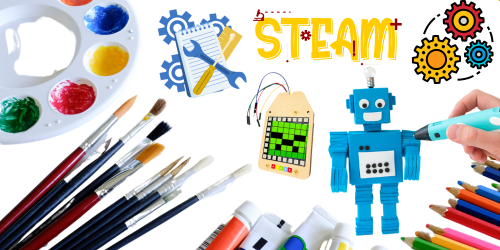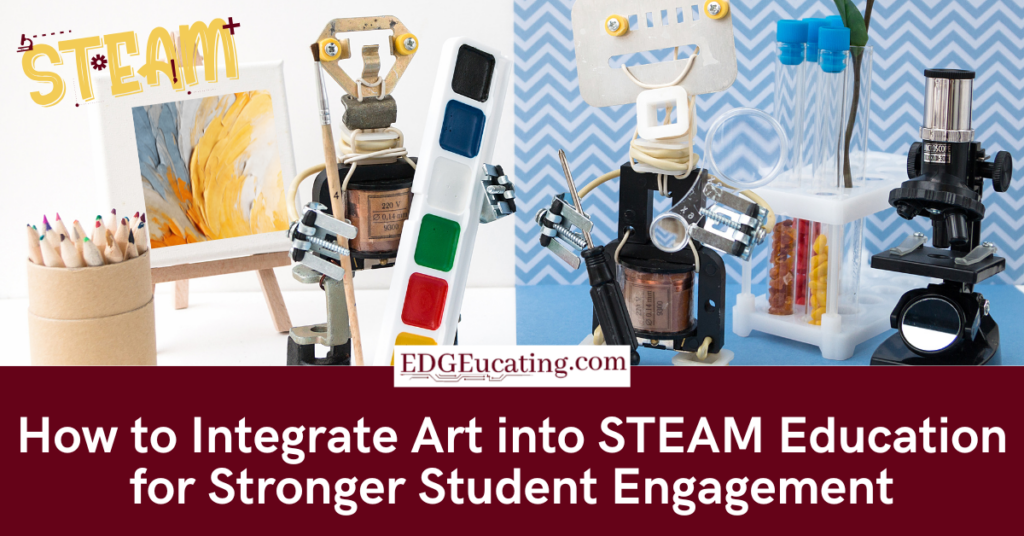In today’s classrooms, student engagement is paramount for meaningful learning. As educators work to cultivate environments that foster curiosity, collaboration, and innovation, the integration of art into STEM—transforming it into STEAM—has become more than a trend. It’s a transformative approach to education that fuels creativity while deepening understanding in science, technology, engineering, and math.
While often underestimated, the “A” in STEAM holds the power to enhance lessons in ways that resonate with diverse learners. Art makes abstract concepts tangible, adds emotional resonance, and allows students to express themselves uniquely while developing core 21st century skills.
At EDGEucating, we’re committed to helping educators bring these ideas to life. If you’ve found value in our articles like Implementing K-12 Technology Integration, From Frustration to Innovation: EdTech Evaluation Tips, or Revolutionizing Education with 3D Printing, you’ll appreciate how this post connects those same themes—technology, engagement, and creativity—within the framework of STEAM education and 21st century skills.
Why Art Matters in STEAM Education
Too often, art is viewed as an “extra” rather than an essential component of student development. But the reality is, art education encourages flexible thinking, risk-taking, and emotional intelligence—skills that support academic success and prepare students for a future filled with unknowns.
Here’s why integrating art matters:
- It brings STEAM Education to life. Visual and performance arts make technical subjects more relatable.
- It cultivates essential 21st century skills. Creativity, communication, and collaboration are as critical as coding.
- It increases student engagement. Artistic tasks give students personal ownership of learning.
- It supports diverse learners. Artistic expression provides alternative ways to demonstrate understanding.
See this overview from The Institute for Arts Integration on what STEAM education is and why it matters. Let’s explore how you can meaningfully incorporate art into STEAM education and elevate your teaching practice in the process.
Key Principles for Integrating Art into STEAM Education
Drawing from the insights presented by years of practical classroom experience, these five key principles can guide your journey in merging art and STEM to teach key 21st century skills.
1. Anchor Learning in Real-World Relevance
To be effective, STEAM education must connect to students’ lives and future aspirations. When students see the practical application of their work, especially in ways that affect their communities, they become invested. This is precisely what the 21st century skills are all about! Using technology such as Makey Makey makes those connections even more tangible and meaningful.
Example Activity: Makey Makey Giant Coordinate Art
Using a floor-sized foil grid and Makey Makey boards, students map their physical movement to digital drawings on Scratch. This teaches coordinate geometry and brings coding and art together through full-body engagement. Students can collaborate to design characters, landscapes, or pixel art and reflect on how technology impacts digital storytelling.
2. Encourage Hands-On Discovery and Artistic Expression
When students work with their hands—whether drawing, designing, or building—they engage more deeply with content. Artistic exploration allows them to experiment, iterate, and think critically about outcomes.
Example Activity: Piper Make Light Show
In this lesson, students program LED matrices to create colorful light displays. They explore how light functions as both a scientific and artistic medium. With coding, students can animate scenes or create patterns that tell a story. It’s an engaging way to explore physics concepts like circuits and light refraction while developing creativity.
3. Promote Accessibility and Inclusivity
Effective STEAM education integration should empower all learners, regardless of background, language, or prior experience. Tools and lessons should be intuitive, flexible, and culturally responsive.
Example Activity: MatataStudio Artist Add-On
Ideal for grades 1–6, MatataStudio offers screen-free, symbol-based coding tools that make programming feel more like play. Students program a robot to draw shapes and designs, including a team badge that reflects their group’s identity. This fosters a sense of belonging and encourages collaboration while reinforcing geometry and visual design principles.
4. Foster Collaboration and Communication
STEAM projects thrive on teamwork. When students brainstorm together, share ideas, and troubleshoot challenges, they build communication skills essential for both academic and professional success.
Example Activity: Loti-Bot Drawing Challenge
Loti-Bot allows students to program geometric drawings using accurate measurements and programmable LEDs. Students work in teams to choreograph light-drawing routines, dynamically blending art and math. These collaborative experiences build trust, foster empathy, and reinforce the value of diverse perspectives.
5. Connect Learning to Future Careers
By integrating art into technical fields, we equip students with essential 21st century skills such as creativity, critical thinking, and problem-solving skills that are vital for success in today’s evolving workforce. Careers in animation, engineering, robotics, and UX design increasingly require a blend of design sensibility and data literacy, making STEAM education a powerful pathway to future opportunities.
Example Activity: KaiBot “Kainundrum” Coding Art
In this lesson, students use visual programming to direct a KaiBot to draw digital art. They learn about X,Y coordinates, patterns, and logical sequencing while creating vibrant, coded artwork. This lesson is heavy in 21st century skills and opens the door for discussions around careers in game development, architecture, and interactive media.
Bringing It All Together: STEAM Education Tools in Action
The beauty of integrating art into STEM isn’t just in theory—it comes alive through hands-on, creative exploration. Tools like Makey Makey showcase how simple circuits can transform everyday objects into instruments of creativity. These STEAM education tools and activities offer powerful ways to elevate engagement, reinforce academic content, and support diverse learning styles. Whether you’re just getting started or looking to expand your toolkit, these examples are classroom-ready and student-approved.

Makey Makey: Giant Coordinate Art
Grade Range: 2–6
Subject Integration: Math + Art + Coding
Turn your classroom into an interactive digital canvas! Using an 18×18 foil grid connected to a Makey Makey board, students physically move across a life-size coordinate plane. Each step maps onto a pixel-based design in Scratch or Python, transforming coding into a kinetic art experience.
? Learning Outcome: Reinforce coordinate plane concepts through physical movement.
Piper Make Light Show: Coding Through Light and Color
Grade Range: 4–8
Subject Integration: Science + Art + Technology
With Piper Make’s Light Show kit, students dive into the magic of light and color as they code custom animations on an 8×8 LED matrix. This lesson transforms abstract circuitry into dazzling, student-generated artwork.
? Project Idea: Host a classroom “light gallery” where each student’s LED pattern shares a story or theme, combining personal expression with technical skill.
MatataStudio Artist Add-On: Drawing the Universe
Grade Range: 1–6
Subject Integration: Art + Geometry + Coding
This screen-free, robot-powered art experience allows students to program MatataBot to draw shapes and symbols, culminating in a collaborative artistic interpretation of the universe. With no prior coding required, it’s accessible for all learners and rich with opportunities for creative collaboration.
? Bonus: Supports social-emotional learning by encouraging teamwork, communication, and meaningful roles for every student.
Loti-Bot: Drawing with Precision and Purpose
Grade Range: 3–6
Subject Integration: Math + Art + Programming
Loti-Bot blends the precision of coding with the creativity of artistic design. Students can program this versatile robot to draw complex geometric art, enhanced with color-changing LEDs and environmental sensors for added interactivity.
? Extension: Challenge students to design symmetrical mandalas while exploring mathematical concepts like symmetry, measurement, and cultural significance.
3Doodler: Symbolic Storytelling in 3D
Grade Range: 4–8
Subject Integration: Language Arts + Art + Engineering
Using this 3D doodle pen, students bring literature and history to life by designing symbolic masks based on themes or characters they’ve studied. It’s an artistic, tactile way to reinforce comprehension and engage visual learners.
? Why It Works: This hands-on activity blends creative expression with deep analytical thinking, making abstract ideas more concrete through 3D design.
Each of these tools includes lesson plans and supports standards-based instruction, making integration smoother and more aligned with curriculum goals and teaching strategies. These tools invite students into a space where logic and imagination coexist. They’re perfect for introducing or expanding STEAM in your classroom—whether you’re working with early learners or middle school makers. You will be ready to begin your STEM and Art, project-based learning strategies with these amazing STEAM Education Tools!
Ready to get started or need support integrating these tools into your curriculum? Let’s connect and create engaging, meaningful STEAM education experiences for your students. Together, we can turn every lesson into an opportunity for innovation. ??
BONUS: Extend Your STEAM Education with 3D Printing
Don’t overlook the creative possibilities of 3D printing in your STEAM program. In our guide, Revolutionizing Education with 3D Printing, we highlight how tools like the 3Doodler or ROBO E4 allow students to bring abstract ideas to life.
Idea: Mondrian-Inspired 3D Geometry
Students can recreate geometric patterns inspired by Piet Mondrian using Tinkercad and then print their artwork. This activity combines visual art, math, and engineering, encouraging students to think critically about form, function, and aesthetics.
Final Thoughts: STEAM Education is for Everyone!
By integrating art into STEM, we aren’t diluting technical learning—we’re amplifying it. Art humanizes STEM. It makes the abstract concrete, the rigid flexible, and the intimidating inviting. Most importantly, it provides students multiple ways to succeed and express their learning while taking student engagement and 21st century skills to a new level—with innovations like Makey Makey showing how accessible STEAM can truly be!
At EDGEucating, we believe education should reflect the world students are preparing to enter—one that values innovation, empathy, and adaptability. If you’re looking for student engagement strategies that stick, STEAM is a powerful place to start.
Looking for more tools to support this journey? Explore our guides on technology integration and evaluating edtech tools to build a foundation for transformative learning.
Together, let’s inspire students to not only understand the world but to imagine what it could become!


